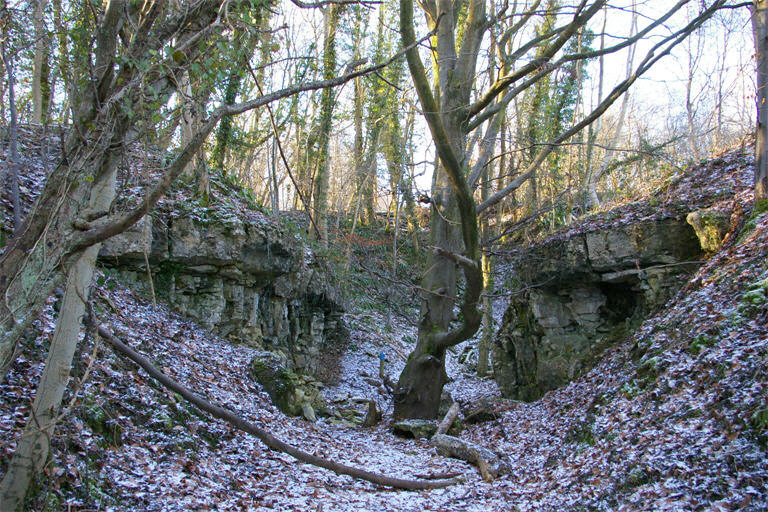
 |
Site 1 - Bath Oolite/Roof Bed (Upper Rags)
|
Leave the car park by the stepped path and follow this path west until you reach a white-topped marker post.
The main path continues straight on, (eventually reaching Site 10). Take the path to the left until you reach Site 1. Look out for rocks on your
left - the blue marker post is towards the back of the site. The site (GPS N 51o23.730' W 002o17.728') will be found
on the left in the trees.
The site is formed by the two walls of an access route to an old mine. Possibly, it was originally an adit mine, (a mine into the hillside) the roof of which collapsed and was cleared. The bottom 2m of the rock faces shows the cream stone, now very fractured, that was used for building. This is the Bath Oolite or Farleigh Down Stone. If this is examined carefully (a hand lens helps) the tiny spherical ooids, or the hollows where they have been, can be seen.
Have a look for fossils in the rock face and fallen blocks. It is unlikely that you will find anything other than shell fragments as the constantly moving water in which the ooids formed was not conducive to marine life. Above the Bath Oolite is a band of hard, fine grained rock, the lower part of the Upper Rags. This was called Roof Bed by the quarry men as it formed a strong roof to the mines. There is a small ‘cave’ where the oolite has been removed from below the Roof Bed. The rock forming the Roof Bed is clearly different from the oolite below, and, although it is not easy to examine it in detail, it does contain a variety of fossils including corals and is referred to as the Coral Bed by geologists. For this rock to form, the agitated water and constantly moving ooid sediment was replaced by a more stable environment in which marine organisms could live. Above the Roof Bed in some places, white oolite (Upper Rags) can be seen indicating that there
was a change back to the type of environment in which Bath Oolite formed.
The Roof Bed acts as a good ‘marker band’in the rock sequence and will be seen at a number of the other sites to be visited. On the west wall there is a small patch of rocks consisting of cemented rock fragments and some pebbles. This is very much younger than the rest of the rock having been deposited probably less than a million years ago and results from rock fragments washing down into rock fissures and becoming cemented. Take great care not to damage this rock. Also in the west wall low down in the Bath Oolite holes made by the quarry men, possibly for fixing Lewis bolts, can be seen. Notice that the layers of rock, where not fractured, are horizontal (flat lying). |

This was the entrance to an old adit mine. The top rock, the Roof Bed, has collapsed.
|